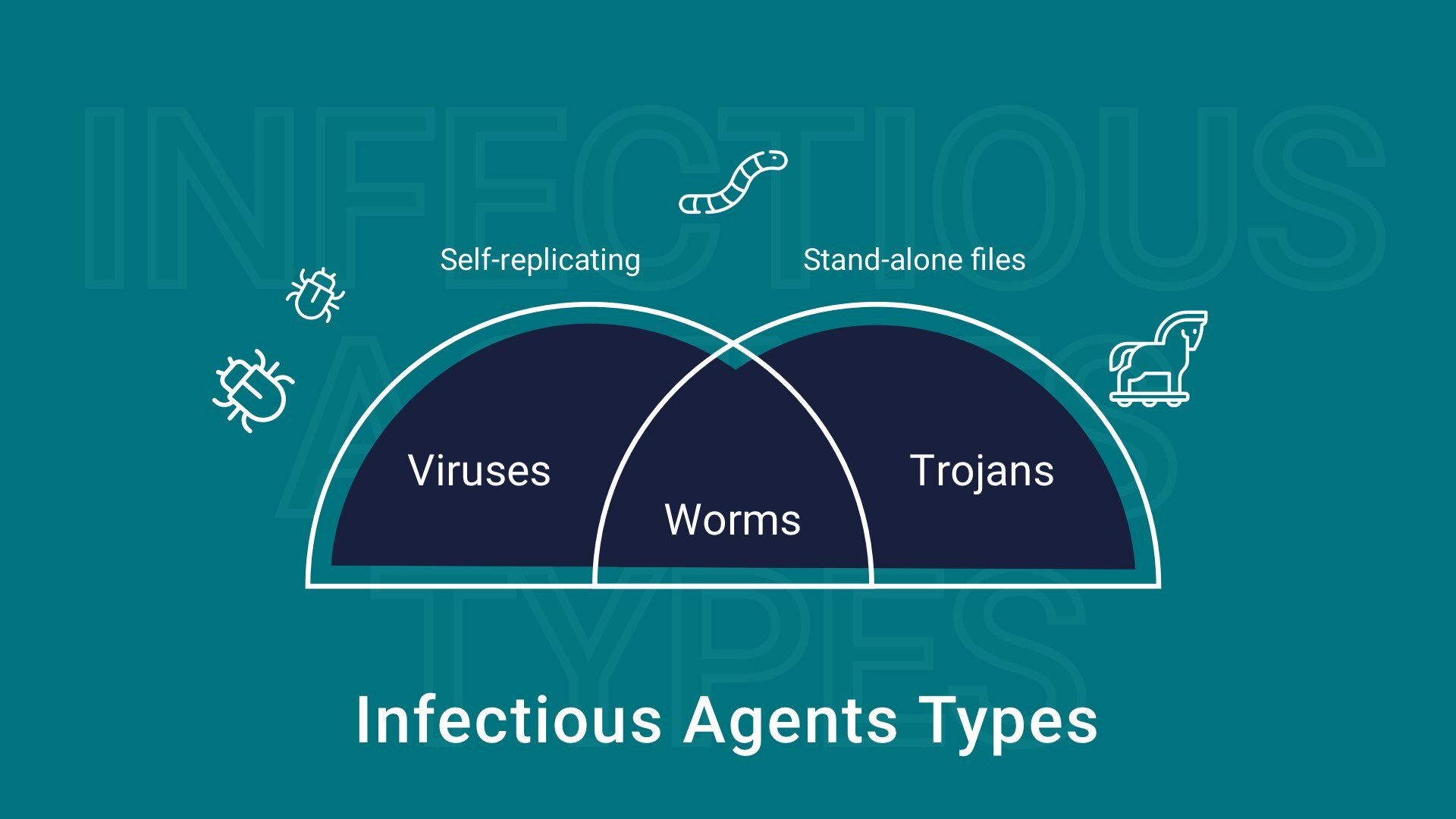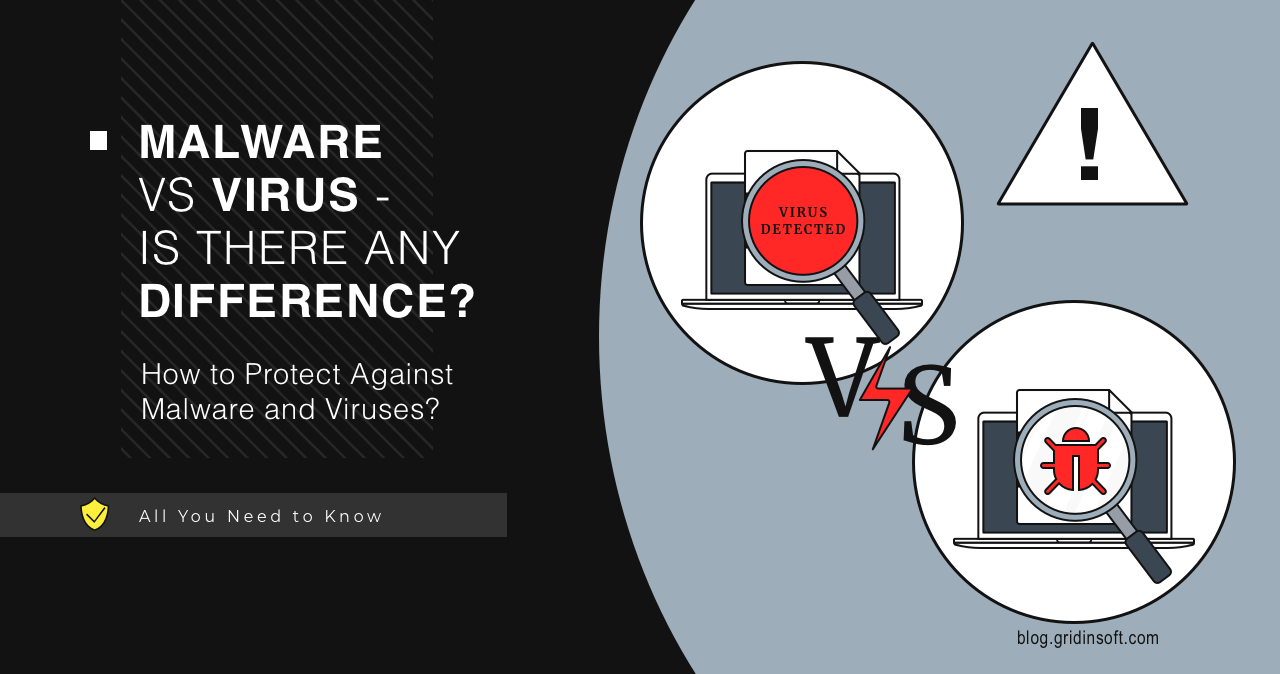It is particularly easy to hear people calling the same thing malware or virus. However, while both terms are often used interchangeably, they carry distinct meanings. In this article, I will elucidate the definitions of each term and explain malware vs virus differences.
Malware vs Virus – Is There Any Difference?
The terms malware and virus are often used interchangeably, but technically, they are not the same thing. In a nutshell, malware is a collective term for any type of malicious software, regardless of how it works, its purpose, or how it is distributed. A computer virus, on the other hand, is just one type of malware. Computer viruses have been around almost since the beginning of the Internet: the first self-replicating virus appeared in 1971. Although it did no damage, simply displaying the “I’M THE CREEPER. CATCH ME IF YOU CAN!” text on the screen, it can technically be considered a virus.

So, all the difference boils down to all viruses being malware, but not all malware being viruses. It’s like calling all copy machines “Xerox” or all portable audio players “Walkman”. Moreover, in addition to the virus category, there are other categories of malware, which in turn are divided into subcategories. We are talking about such categories as worms, trojan horses, rootkits, stealers, spyware, ransomware, adware, etc. Now, we will take a closer look at all of them.
What is Malware?
Malware stands for malicious software, one that aims at damaging the system, files in it, or uploading these files to a remote server. The range and history of malicious software is vast, with changes happening almost every day. Nowadays, malicious software aims almost exclusively at earning money in this or another form. As a result, some analysts classify modern malware as crimeware. Let’s see some of the most widely used malware types.
- Dropper
- Spyware
- Infostealer
- Ransomware
- Remote-Access Trojan (RAT)
- Backdoor
- Adware
- Virus
- Computer Worm
This is not a complete list of threats, but the most widespread malware types. Some of the modern malware samples can possess functions typical for other malware types. For example, a dropper can collect user data, akin to an infostealer, or adware may act as a loader.
What is Virus?
A computer virus is a type of malicious software. While there are many variations of viruses, they all share the ability to spread through self-replication. Victims activate viruses by opening infected applications or files. Viruses are commonly spread through web applications, software, and email. They can also be transmitted via infected websites, content downloads, and removable media.
The term “virus” has become synonymous with malware due to historical reasons, propagation methods, media popularization, and the broadening of the term to encompass various types of malicious software. Computer viruses have existed since the early days of computing, but “real” viruses began to emerge in the 1980s. The earliest canonical virus is considered to be the Elk Cloner, created in 1982 by high school student Rich Skrenta. It infected Apple II computers and spread via floppy disks. Though harmless, it was the first to spread beyond a single computer system.
Malware and Virus Examples
To summarize, let’s review a real representative of threats. Here, I have gathered the most prominent examples of different types of threats, along with their properties and their impact on cyberspace:
ILOVEYOU
The ILOVEYOU virus, an email worm, was released in 2000 by two Filipino college students. It quickly spread worldwide through email attachments, deceiving users into opening them. Once opened, the virus overwrote essential system files, leading to computer crashes and data loss. Additionally, it automatically sent copies of itself to every contact in the user’s address book. The global damages caused by this virus were estimated to be around $15 billion.
Emotet
The Emotet Banking Trojan, originating in 2014, was initially developed to steal banking credentials. However, it evolved into a highly modular and sophisticated malware capable of delivering various payloads. It primarily spread through spam emails and quickly became one of the most prevalent and costly forms of malware. Emotet was frequently utilized to distribute ransomware and other malicious software.
WannaCry
The WannaCry Ransomware attack of 2017 exploited a vulnerability in Windows systems to encrypt files and demanded ransom payments in Bitcoin for decryption. It spread rapidly across networks using the SMB protocol, infecting over 230,000 computers in 150 countries. The attack caused widespread disruption, notably affecting the UK’s National Health Service (NHS).
How to Protect Against Malware and Viruses?
To safeguard against malware and viruses, it’s crucial to employ a robust, advanced anti-malware solution. As the cyber threat landscape evolves, so do anti-malware developers. Today, there are numerous high-quality products available, including GridinSoft Anti-Malware. In addition to its primary protection features, it includes an Internet Security module, which has become more of a necessity than an optional add-on. Given that the majority of malware is now propagated via the Internet, I strongly advise utilizing Internet Security for enhanced protection.
Equally important is exercising vigilance while browsing the web. Practicing good cyber hygiene is paramount, which means refraining from clicking on suspicious links or opening email attachments from unknown senders. Adhering to these fundamental rules can significantly decrease the likelihood of falling victim to any of the aforementioned threats.





